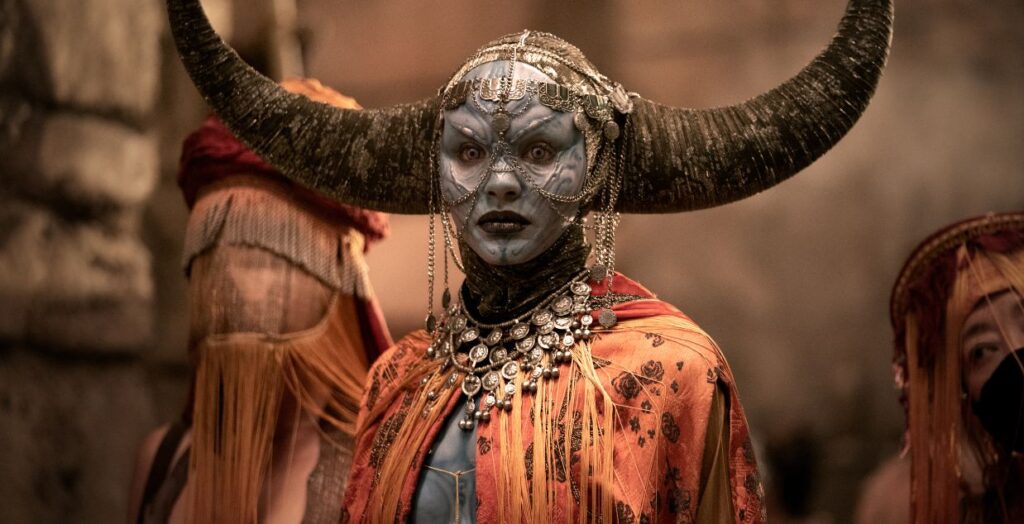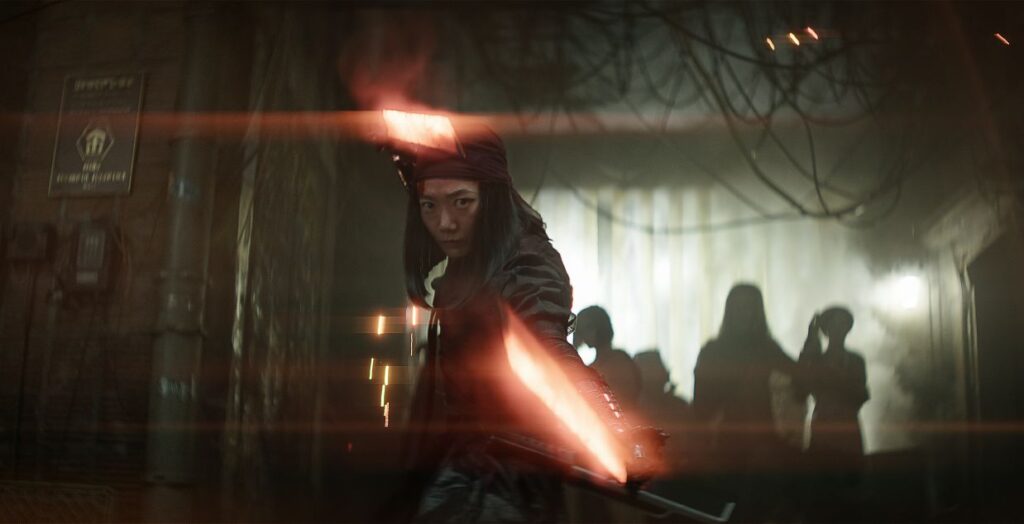For a thousand years, a single dynasty forged an empire that commanded all it held in its gaze. But with the recent assassination of the king and queen, the line has been broken, and some are willing to test the new ruling powers to see if their grip is as tight as those who ruled before them. In Rebel Moon Part 1: Child of Fire, directed by Zach Snyder and written by Shay Hatten, Kurt Johnstad, and Zach Snyder, viewers are taken to a backwater planet where a small, unimportant village is about to get dragged into the brewing conflict along with a secret individual living among them who may yet turn the tide
Nothing causes something to fail at a goal like trying far too hard to achieve it. Whether it’s an individual trying to look tough or a science fiction story that wants the viewer to believe that it belongs among the great epics that came before it, those who observe these displays do not walk away convinced of the desired message, but rather, they walk away pitying the level of insecurity and neediness they project. While Rebel Moon Part 1 takes some big swings, it ultimately falls flat, trying to showcase too much, too fast, and leaving the viewer with that overwhelming feeling of desperation to impress.
The movie opens with a sizable information dump as it lays out the important elements of the world’s history.Paired with the appearance of an impressive-looking starship coming out of this setting’s version of hyperspace, both audio and visuals set the tone and scale for the coming film. The CGI is crisp and clean, as will the visual effects be throughout the story’s two-hour and fifteen-minute runtime. However, this is the first element of many that leans into my above critique.

‘The film tries too hard to push the scale it boasts. One of the ways in which it does this is by calling out things like how the dynastic line of this empire had been unbroken for a thousand years. While this sort of scope is good to give a viewer, working it into a conversation rather than outright exposition avoids the feeling that it is there to impress, as opposed to building out a world seamlessly and naturally.
From this initial display of the intimidating authority of the central government’s Imperial power, the film jumps to our small farming village, where we are introduced to the film’s lead, Kora (Sofia Boutella, Guillermo Del Toro’s Cabinet of Curiosities). Seen guiding a plow horse across a field with an enormous, red, ringed planet in the background, this shot is visually stunning. From here, the film begins its work to establish the idyllic life of this small farming village.
It is a bit ironic that the sequence the film handles best is the one that has nothing to do with epic grandeur. The presentation of the town and the joyful, if simple, life it provides its people is filled with warmth and goodness. Kora is called from the field to participate in a feast, celebrating the coming planting and petitioning the gods to bless their future crops. Food, drink, and celebratory mating (don’t worry, it’s off-screen) are all on the menu. The sheer joyful energy that fills the gathering ensures that it will hit the viewer when the world comes crashing down around them.
Sure enough, the next day, the residents of the village begin planting their crops, only to have their day disturbed by the appearance of a Dreadnaut class starship, King’s Gaze. Led by Admiral Noble (Ed Skrein, Alita: Battle Angel), the Imperial landing party brings demands of grain to support its troops as they root out local resistance elements.

Here, we see Snyder’s vision come in with all the subtly of a sledgehammer. The viewer needs to know that the Imperial government is evil, and the film wastes no time in establishing this fact. Noble and his men go to such egregious lengths to showcase how bad they are that it borders on the ridiculous. Harm is not only directed at beloved leaders of the community, but the troops waste no time pushing far more indiscriminate violence upon the community, all but ensuring an eventual loss of compliance from the townspeople. These people aren’t just evil. They seem psychotic, so much so that it makes the viewer wonder how they could ever manage to build up such a grandiose empire in the first place.
It also undercuts Noble as the major villain of the film. Science fiction tales are filled with intimidating bad guys that make not only their worlds’ but the audience themselves quake. Noble, sadly, does not fit this bill. Rather than a powerful threat, Noble comes across as a bully, one who has more likely earned his lofty spot in the Imperial Navy through family connections than success in combat or governance.
Wedged in the middle of Rebel Moon Part 1’s opening descent into peril for the village is a perfect highlight for another of the film’s major failings: rushed character arcs. The rest of the time spent in the village is spent in a worldwide of introducing characters, speedily setting up an arc that feels like it could play out over the course of the entire film, only to see it resolve less than ten minutes after its introduction. Making the effect even more lessened is the fact that much of the drama that plays out is telegraphed beforehand, making the direction of these character narratives completely predictable.
This madcap rush through character arcs continues throughout the story. Once the immediate situation is resolved, Kora, along with another farmer, Gunnar (Michiel Huisman), seeks to make contact with those who may help defend the town from the retribution that will come once the empire learns that the troops left behind have been killed.

For the next third of the movie, we are introduced to an assemblage of rough and ready fighters either looking to be heroes or simply out for vengeance. As each is recruited, we get a sequence showcasing their talents or the resources they bring to the enterprise. The movie is so hard-pressed to fit these entries in, though, that we get little time with the growing cast in between additions, making several of Rebel Moon Part 1’s final moments far less impactful than they are clearly intended to be. Sacrifices, betrayals, and heroic victories feel empty, even as the film does everything it can to push how impressed and dazzled the viewer should be.
While the forced speed of the narrative makes story beats and characters never land, the actors themselves feel like they are giving their all to breathe as much life into their personalities as the plot permits. Charlie Hunnam works hard to craft the roughish smuggler energy his character is going for, while Djimon Hounsou breathes as much of the command presence his failed general persona can in the handful of moments he actually gets to speak. I genuinely felt sorry for the cast as they seemed to really feel for the roles they had been asked to bring to life but were never given the means to do so.
Furthering the loss of impact for many of these moments is the less-than-stellar choreography in Rebel Moon Part 1. While I would never call it bad, it fails to create the image of skillful warriors it strives for. Kora is clearly intended to be a John Wick-level combat monster, slaying large numbers of enemies single-handedly. Sadly, the choreography never manages to make Kora feel nearly so deadly, and her opponents never feel like they are as hard a challenge as the ones delivered in the aforementioned franchise.

Half of what makes a hero feel exceptional is overcoming a villain that is equally so. Kora is never given that chance, as her antagonists never fail to elevate themselves beyond forgettable cannon fodder. Even the climactic final one-on-one fight is against an opponent whose only melee accomplishment to that point is beating an unarmed man to death with a glorified walking stick. I should hope our mysterious, badass lead can handle him.
The other thing that does the combat in Rebel Moon Part 1 no favors is Snyder’s continued obsession with slow motion. If you are one of the many who feels like overuse of this technique sucks the life out of combat sequences, you will not enjoy this ride. If you do, this film may be for you.
The only element that shines brightly throughout Rebel Moon Part 1 is its score from composer Tom Holkenborg. From start to finish, the music is filled with sweeping themes, energetic fight music, and ominous tones that feel like they deserve to be attached to a better movie. It works so hard, but music in cinema is like the sauce on a steak, if the steak is overcooked, no amount of sauce can make it good, it can just make the meal pass a bit less painfully.
While Rebel Moon Part 1: Child of Fire displays some strong visual effects and a gorgeous soundtrack, virtually everything else in the film fails. Rushed arcs, underwhelming combat, and the need to push the scale and grandiose nature of the setting bring the narrative down, making it underwhelming at best and outrightly bad at worst.
Rebel Moon Part 1: Child of Fire is streaming now on Netflix.
Rebel Moon Part 1: Child of Fire
-
Rating - 4/104/10
TL: DR
While Rebel Moon Part 1: Child of Fire displays some strong visual effects and a gorgeous soundtrack, virtually everything else in the film fails. Rushed arcs, underwhelming combat, and the need to push the scale and grandiose nature of the setting bring the narrative down, making it underwhelming at best and outrightly bad at worst.





